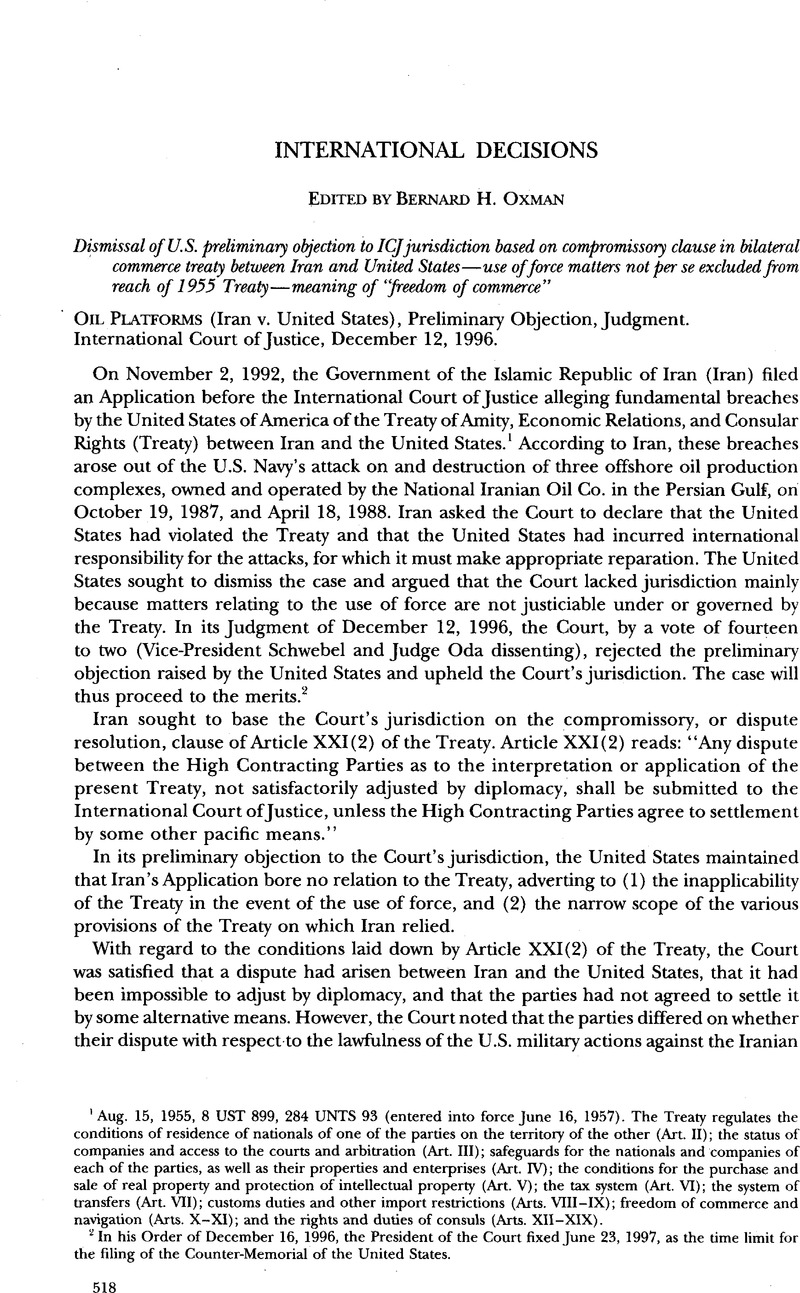Article contents
Oil Platforms (Iran v. United States)
Published online by Cambridge University Press: 27 February 2017
Abstract

- Type
- International Decisions
- Information
- Copyright
- Copyright © American Society of International Law 1997
References
1 Aug. 15, 1955, 8 UST 899, 284 UNTS 93 (entered into force June 16, 1957). The Treaty regulates the conditions of residence of nationals of one of the parties on the territory of the other (Art. II); the status of companies and access to the courts and arbitration (Art. III); safeguards for the nationals and companies of each of the parties, as well as their properties and enterprises (Art. IV); the conditions for the purchase and sale of real property and protection of intellectual property (Art. V); the tax system (Art. VI); the system of transfers (Art. VII); customs duties and other import restrictions (Arts. VIII–IX); freedom of commerce and navigation (Arts. X–XI); and the rights and duties of consuls (Arts. XII–XIX).
2 In his Order of December 16, 1996, the President of the Court fixed June 23, 1997, as the time limit for the filing of the Counter-Memorial of the United States.
3 Preliminary Objection, Judgment, para. 16 [hereinafter slip op.].
4 1986 ICJ Rep. 14, 116, para. 222, & 136, para. 271 (June 27).
5 Slip op., paras. 20-21.
6 Id., paras. 28, 31.
7 Id., paras. 35-36.
8 Id., paras. 41-52.
9 Id., para. 53.
10 Obviously, this question is different from that of the burden of proof: there, the Court’s dictum applies that “it is the litigant seeking to establish a fact who bears the burden of proving it.” See Military and Paramilitary Activities in and against Nicaragua (Nicar. v. U.S.), Jurisdiction and Admissibility, 1984 ICJ Rep. 392, 437, para. 101 (Nov. 26).
11 Factory at Chorzów (Ger. v. Pol.) (Claim for Indemnity) (Jurisdiction), 1927 PCIJ (ser. A) No. 9, at 32 (July 26).
12 It is unclear why the ICJ relied heavily on the intention of the United States, as expressed in various documents, in accepting that party’s objection to the jurisdictional basis of Article I of the Treaty, but rejected its objections in relation to Article X, given that the essence of the U.S. objections to both provisions was that the Treaty was never intended to govern the use-of-force issues raised by Iran’s Application. Arguably, the Court’s statement that “at no time did the United States regard Article I as having the meaning now given to it by the Applicant,” slip op., para. 29, applies equally to Article X of the Treaty.
13 For an exposé on the issue of standard of proof, see Judge Shahabuddeen’s dissenting opinion in Maritime Delimitation and Territorial Questions between Qatar and Bahrain (Qatar v. Bahr.), Jurisdiction and Admissibility, 1995 ICJ Rep. 6, 62-65 (Feb. 15). Judge Higgins points to the marked uncertainty in the practice of the Court on this issue and offers her own interpretation of the Court’s case law in her separate opinion.
14 See slip op., Separate Opinion of Judge Higgins, paras. 9-26, for a summary of these different lines of holding.
15 1988 ICJ Rep. 69, 75-76, para. 16 (Dec. 20).
16 Judge Oda points out in his dissenting opinion that the record before the Court does not show that there had been prior diplomatic negotiations between Iran and the United States in the five-year period from the first attack until the filing of the Application by Iran, and that, on this basis alone, Iran’s Application could have been dismissed. Arguably, therefore, the issue to be decided by the Court was one of the admissibility of Iran’s Application (in addition to one of jurisdiction).
17 See also slip op., Dissenting Opinion of Judge Oda, para. 16. This goes far beyond the test proposed by Judge Shahabuddeen in his separate opinion: that the Court simply determine whether the construction of the treaty relied on by the applicant is an “arguable” one.
18 1980 ICJ Rep. 3 (May 24).
19 1986 ICJ Rep. 14 (June 27). However, Vice-President Schwebel argues in his dissenting opinion that the Court was free in the present proceedings objectively to apply the terms of Article XX of the Treaty, given the peculiar history of the 1986 precedent, the U.S. position and the Court’s responsibilities in this case.
20 In the final paragraphs of his separate opinion, Judge Shahabuddeen points out that if the Court renders a definitive interpretation of the Treaty in deciding on its jurisdiction, it is difficult to see why that interpretation should not govern at the merits stage. However, the Court is still required at the merits phase to make an independent evaluation of exactly what the facts are and how any defenses of the respondent relate to the possible breaches of the law applicable to the dispute. In fairness to the applicant, the Court must equally guard itself against attempts by the respondent to raise a merits-related objection to jurisdiction and thus preclude further proceedings simply by raising it in limine litis.
21 See slip op., Dissenting Opinion of Judge Oda, para. 26. According to the most senior ICJ judge, obtaining access to the ICJ on this basis would constitute “nothing short of an abuse of treaty interpretation.”
- 2
- Cited by




